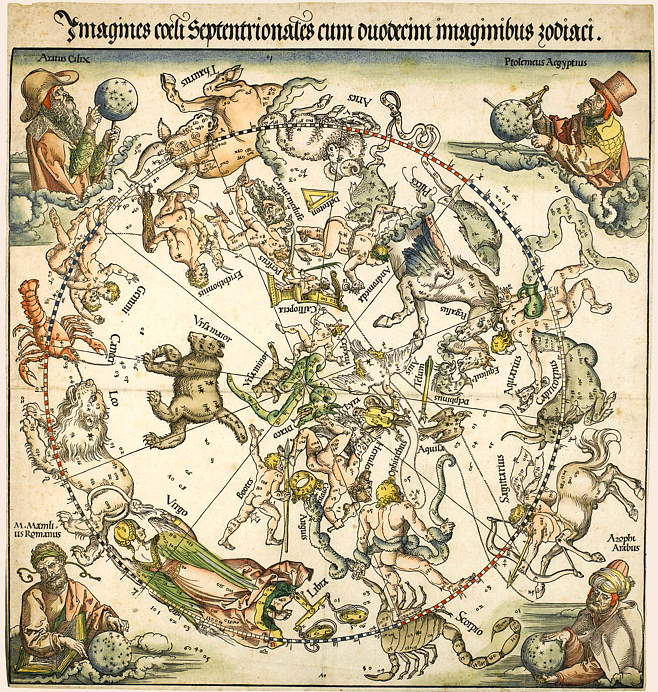
By Patrick Hunt –
Albrecht Durer is an artist famous for multiple endeavors, including woodcut and painting media. But he is also a pioneer illustrator of European star charts, especially his 1515 collaborative work for making a pair of woodcuts of the northern and southern hemisphere night sky images that have graced historical astronomy for half a millennium. His woodcut pair is claimed to be the first printed star map in Europe, justifiable because it was disseminated to an audience wider than only a few scholars, since so many prints could be quickly printed and distributed after the advent of the printing press. [1]
Historical astronomers have long admired this 1515 illustrated and colored woodcut pair Imagines coeli Septentrionales et Meridionales zodiaci not only for their stunning accuracy of visual representation of the constellations in zodiacal lore but also for their historical significance in acknowledging and honoring ancient astronomers like Aratus, Ptolemy, Marcus Manilius and Al-Sufi as precedents and sources, a form of historiography uncommon even in the Renaissance when documentation began to be more highly appreciated.
I’ve found myself poring over these star maps more than a few times in the past several years for different reasons. First, I’ve given lectures where Albrecht Durer figures in major ways, including at Stanford University Cantor Center for the Visual Arts (formerly Stanford University Museum) in a series on Renaissance chiaroscuro in 2011. Second, I’m an admirer of Nick Kanas, whose superb book Star Maps I reviewed in 2007. I return to this book frequently, including recently when I was asked to give an invited summer night star talk, “Stars in Myth and Fact” where a devoted group of stargazers gathered under a night sky at over a mile elevation at Martis Camp near Lake Tahoe with a mesmerizing celestial display of stars, a night vista also filled with the Milky Way in a rare event of visual magnificence humbling to us all (see July photo below); also a similar invited talk given at the July 4, 2011 Renaissance Weekend in the Grand Tetons at Jackson Hole Lodge for a group of hundreds. I had brought Nick’s beautifully written and illustrated book along for reference as he devotes ample space to Durer’s historic work – and, as usual, I could not easily put it down. Note the Milky way (Via Lactea in Latin in the myth of Juno and Hercules or Hera and Heracles) in both the time lapse photo and Durer’s Septentrionales image.

The story of the origin of the Milky Way is a humorous Classical myth story of how Juno was tricked by Jupiter and Venus (with the help of Cupid’s arrow) into temporary maternal care for infant Hercules, offering him the milk of immortality from her divine breast as Jupiter and Venus had hoped. Juno was momentarily unaware this was the child she hated (because he was not her own child but of a mortal woman her philandering husband had chosen to bear a hero). Juno only discovered the ruse when the infant Hercules gave a mighty suck at her breast, and in anger she threw the baby down as her milk spilled across the sky, as Tintoretto’s painting around 1575 shows in a shower of stars below. As some ancient Classical Greeks saw it, the MIlky Way is therefore a milky whitish band of dense stars whose luminosities merge.
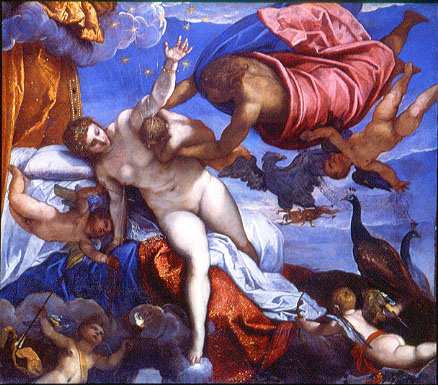
Durer’s direct involvement with this precedent setting enterprise of the star charts was for the court of Emperor Maximilian I and partly sponsored by Cardinal Matthaius Lang von Wellenburg (1469-1540) of Salzburg. Durer’s collaboration was with two noted Renaissance scientists who were both contemporary astronomers and mathematicians, skills the artist shared to some degree in his own right as a keen draftsman although on a much smaller scale: for his pioneering scientific observation on anatomy and natural history see his 1502 “Young Hare” Feldhase”] watercolor; for his highly regarded geometry and numerical puzzles (e.g., “magic square”) see his famous 1514 woodcut “Melencholia”. [2]
The first collaborator was Johannes Stabius (1450-1522), originally Stab, mathematically-trained imperial astronomer and cartographer employed like Durer in the court of Maximilian I in Vienna.[3] Stabius created the coordinate system for the star charts, re-ingineered by Durer to his own numerical specifications. Durer’s second collaborator was clerical astronomer and mathematician Konrad Heinfogel (c. 1455-1517) from Nuremberg, also Durer’s own city – whose Sphaera materialis was being compiled but published in 1516 just after this collaboration.[4] Few realize that Durer himself was more than a mere amateur astronomer, as he bought a house in Nuremberg with an observatory on the top, according to Dackerman. [5] Perhaps the best current discussion of this pair of woodcuts is by Ian Ridpath, [6] editor of the Oxford Dictionary of Astronomy, whose astronomical training began at the University of London Observatory and whose many accolades include the Klumpke-Roberts Award from the Astronomy Society of the Pacific and praise from Sir Martin Reeves, Royal Astronomer.
On the four corners of the Septentrionales (North Hemisphere) page outside the images of the 12 zodiacal constellations (cum duodecim imaginibus zodiaci), Durer has shown in chronological order from top left to bottom right his four historical astronomers who contributed to the development of star charts in some way or another. First, is Aratus of Cilician Soli (here Aratus Cilix) ca. 315-240 BCE, then Claudius Ptolemy (here Ptolemeus Aegyptius) 90-168 CE, author of the Almagest, Marcus Manilius (here M. Mamlius Romanus) circa 1st century CE and likely author of the Astronomica, and Al-Sufi (here Azophi Arabus) 903-986 CE, whose full name was Abd al-Rahman al-Suf and author of the famous astronomical tome Book of Fixed Stars, published in 984, and corrector of Ptolemy’s Almagest. Objectivity of paying tribute to Arab astronomers is critical – many of the formal star names currently in global use are in Arabic and these antecedents rarely receive their due. I wrote a few encyclopedia articles a few years ago on Roger Bacon and Galileo respectively and was surprised how few people knew that both Bacon and Galileo paid tribute to Al-Haytham (ca. 965-1040 CE) as a medieval precedent astronomer and mathematician in Baghdad and Cairo before the advent of modern European astronomy.[7] But Durer was surprisingly up-to-date and historically correct in giving Al-Sufi proper credit. He also shows these astronomers with appropriate astronomical accoutrements: each is holding a sky globe, but Ptolemy has an added pair of measuring divider calipers, and Marcus Manilius also holds a book open to calibrate his measurements to known data.
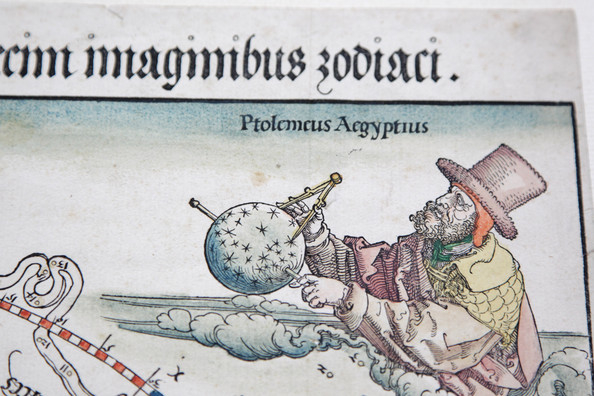
One of the features Durer improved from Heinfogel’s prior works with faint images in addition to the lifelike qualities of all the figures was the precise and quantitative radial projection as each constellation or star was fixed by coordinates around the hemisphere. Apparently star coordinates were the work of Stabius along with star positions derived from Heinfogel. Durer’s careful amalgam of the two charts in radial format (radial lines at 30 ° intervals as Ridpath shows) is impressive for his artistic realism current for the day (note his ancient astronomers are all in contemporary garb). Some of Durer’s improvements include major constellation stars as asterisms like those of Ursa major (aka “Big Dipper” aka “The Plough” to Britons from the Roman Era onward aka “The Wain or Wagon” to Celts who used wagons in their Iron Age migrations across Europe). These are seen in the Septentrionales woodcut contrasted with minor stars numbered according to Ptolemy’s Almagest star numberings or lesser stars just shown as small circles. Notice Ursa major‘s dual midriff stars (the edge of the dipper) also accurately point to Polaris the North Star, the fnal star in the tail of Ursa minor.
These two examples of Durer’s two woodcuts – here in almost priceless condition [8] – were colored in his own time and it is important to note they represent the night sky looking up but with the constellations reversed, as Ridpath has shown, progresssing counterclockwise.
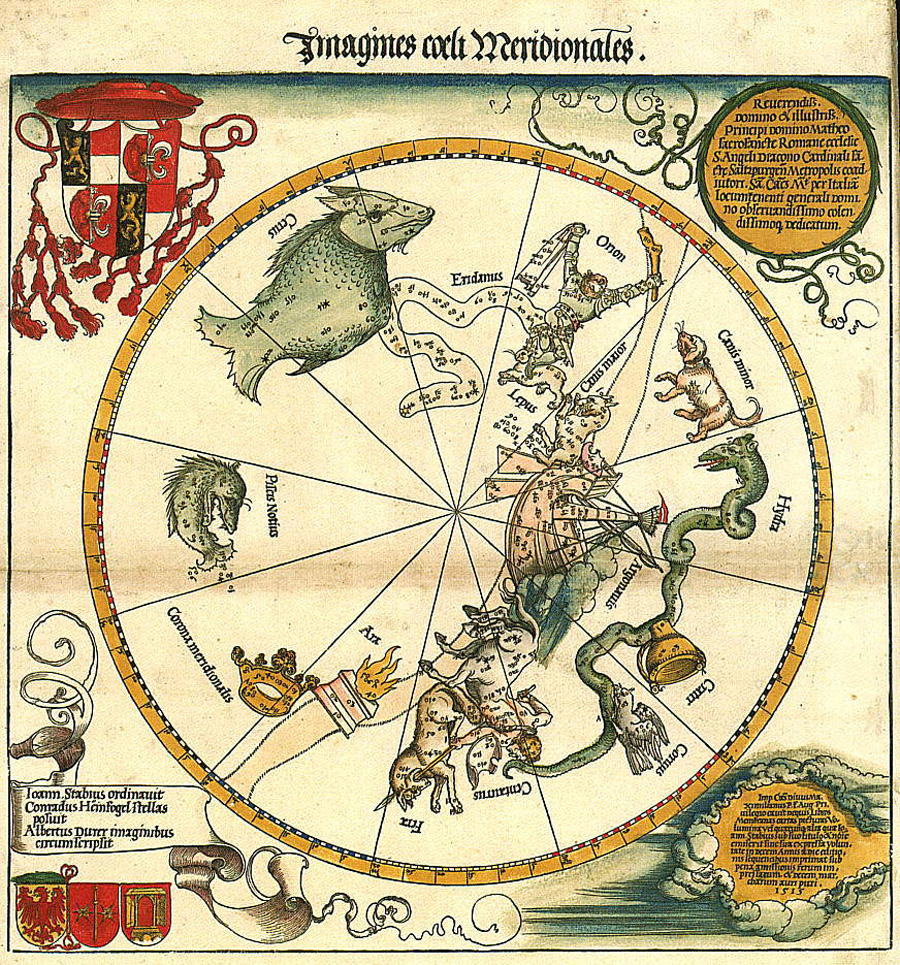
Durer’s companion Meridionales (Southern Hemisphere) woodcut has fewer constellations because this part of the sky had not yet been much mapped out by Europeans, since this was only the beginning of the Age of Exploration in the Renaissance. Primary identified constellations along the unfinished mapping of the southern sky, falsely appearing like a less crowded portion of the Milky Way, include the Argonavis (the ship of the heroic Argonauts sailing vast unknown seas), Centaurus, Canis major, Canis minor and of course Orion, mostly seen in the Northern Hemisphere in winter. Ridpath points out that Marcus Manilius (one of Durer’s astronomers) compared the MIlky Way “to the luminous wake of a ship”, which is fitting here in that the ship Argo plies it.[9] Also noteworthy at top left is the heraldic blason of Cardinal Matthaius Lang von Wellenburg surmounted by the distinctive red cardinal’s hat. Lang also later became Prince-Archbishop of Salzburg. Stabius is also acknowledged as the creator of the cordiform projection that later bears Johannes Werner’s name, the Werner Projection, although he credited Stabius.[10] Durer’s own heraldry follows that of Stabius and Heinfogel at bottom left.
Also notable in the collaboration in this star chart pair, it is fitting to see that the collaborators’ different tasks are delineated: Ioann[es] Stabius ordinavit (“Johannes Stabius put in order”), Conradus Heinfogel stellas posuit (“Conrad Heinfogel placed the stars”), and Albertus Durer imaginibus circumscripsit (“Albrecht Durer circumscribed [visualized] these images”), including the realism of the Milky Way, however previously imagined. As Ridpath notes, the Milky Way was not a constellation but important in its own right, and heavenly luminaries deserved a celestial highway, as Ovid described it in Metamorphoses I.168ff: “When skies are clear a path is well defined on high, which men, because it is so white, have named the Milky Way (Via Lactea). It makes a passage for the gods and leads to the heavenly mansions on either side of it, to Jupiter’s imperial home. [11] One wonders whether Durer knew this Ovid passage, well-educated and avid collector that he was, owning a library ranging from mythology and theology to Euclid and a 1499 copy of F. Colonna’s Hypnerotomachia Poliphili (published by Aldus Manutius in Venice) and many other seminal works. In 1509, prior to making this woodcut star chart pair, Durer also bought the Nuremberg house from the estate of the recently-deceased mathematician and astronomer Bernhard Walther (ca. 1430-1504) [12], complete with its rooftop observatory that he soon utilized. If nothing else, this pair of star chart woodcuts confirm Durer’s astronomical interest as beyond mere illustration and anything but amateur.
Last but not least, it is interesting that Durer, whose work we actually see the most visibly on this star chart pair, lists himself last, whether from humility or as dictated previously by his collaborators, but it is also ironic that his name is the most famous of this project half a millennium later.
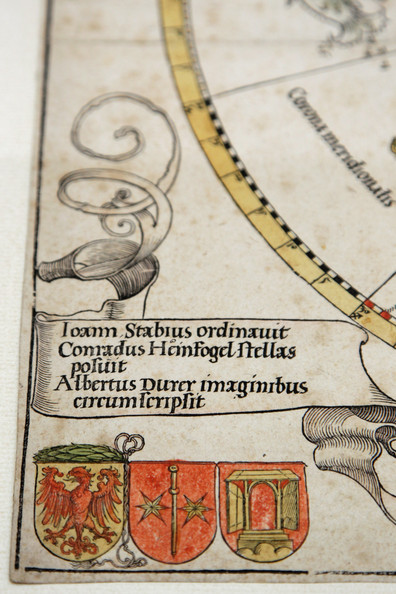
This pioneering star chart and the collaboration that made it possible are representative of what a great artist like Durer, who was also deeply scientifically oriented, achieved for the discipline of astronomy, influencing its history with new visual precedents of the highest quality and precision.
Notes:
[1] Nick Kanas. Star Maps: History, Artistry and Cartography. Springer/Praxis, 2007, 139.
[2] P. J. Federico. “The Melancholy Octahedron” Mathematics Magazine (45) 1972, 30-36; Terence Lynch. “The Geometric Body in Durer’s Engraving Melencholia I.” Journal of the Warburg and Courtauld Institutes XLV (1982) 226-32; Corydon Ireland. “When Art Influenced Science” Harvard Gazette, December 2011; (Susan Dackerman. “Taking Durer out of the Box” Harvard University – Sackler Museum Lecture Series [InSight Evenings]/ also see “The Resonant Scientific Collaboration of Albrecht Durer,” SciMed Horizons, TS-SI News Service, Dec. 18, 2011. http://ts-si.org/horizons/31240-the-resonant-scientific-collaboration-of-albrecht-duerer); Eric Weisstein, “Durer’s Solids” Wolfram MathWorld (2012) (http://mathworld.wolfram.com/DuerersSolid.html).
[3] Erika Rummel. “Review of Franz Posset, Renaissance Monks: Monastic Humanism in Six Biographical Sketches.” Studies in Medieval and Reformation Traditions: History, Culture, Religion, Ideas 108. Leiden: Brill Academic Publishers, 2005, Renaissance Quarterly 59.2 (2006) 573-5, esp. 574.
[4] Rudolf Simek. Heaven and Earth in the Middle Ages: The Physical World Before Columbus. Boydell Press, 1997, 17.
[5] Corydon Ireland in Harvard Gazette (2011), see note 2 above.
[6] Ian Ridpath is the author of over a dozen astronomy books, many of them the best astronomical history sources not just in Britain but globally, including the highly useful Star Tales (Lutterworth Press, 1988); Ridpath also edits the British magazine Popular Astronomy (also see http://www.ianridpath.com/startales).
[7] Patrick Hunt. “Roger Bacon” and “Galileo” in Great Lives in History: Inventors & Inventions, Salem Press, 2009. Note Abu ‘Ali al-Hasan ibn al-Hasan ibn al–Haytham is also known as Alhazen in the West; sometimes also known as Ibn Al-Haytham al-Basri from his place of birth.
[8] This contemporarily colored pair of woodcuts sold at Sotheby’s in London in March, 2011 for £361,250 (578, 542) because the coloring was done in the Renaissance, a rare happening.
[9] Ian Ridpath. Star Tales. Cambridge: Lutterworth Press, 1988, 135.
[10] Ruth Watson. “Cordiform Maps Since the 16th Century: The Legacy of Nineteenth Century Classificatory Systems”. Imago Mundi 60.2 (2008) [International Journal for the History of Cartography], 190 note 4: Joanne Stabio haud vulgari Mathematico…earundem figurationum theoriam ac primaria incunabula mihi suggerente… (J. Werner, Libellus du quatuor terrarum orbis) [‘Johann Stabius was no ordinary mathematician…representing the primary theory and the cradle of my suggestion…].
[11] Ridpath, 1988, 135
[12] Jeffrey Chipps Smith. “Albrecht Durer as Collector: Josephine Waters Bennet Lecture at the Renaissance Society of America Plenary Meeting in Venice, Italy, April, 2010.” Renaissance Quarterly 64.1 (2011) 1-49. Note: I was at his April 10, 2010 lecture in Venice.